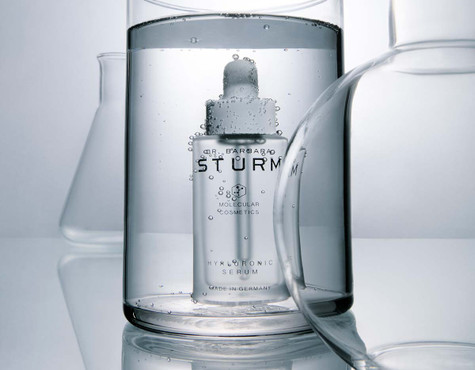WHAT IS HYALURONIC ACID?
27th Jan 2025
The multitasking molecule promises optimum skin health, intensive hydration and a plumper, dewier complexion. Here’s what you should know about Hyaluronic Acid.
WHAT IS HYALURONIC ACID?
Hyaluronic Acid is a naturally occurring compound in our bodies. It is one of the main components of the extracellular matrix: a three-dimensional network of extracellular macromolecules, like collagen, enzymes (proteins), and other important proteins, that provide structural and biochemical support of surrounding cells, making it indispensable for cell skeletal structure. It also maintains moisture in our eyes, lubricates the joints, reduces inflammation, helps heal wounds, maintains our cellular moisture and keeps skin looking young and healthy. And it's been proven in clinical trials to promote the skin’s natural barrier function. Like other substances, we produce less Hyaluronic Acid as we age; people from their late 40’s have half as much Hyaluronic Acid in their bodies as those in their 20’s - and as a result, our skin loses volume, hydration and plumpness, leading to the appearance of fine lines, wrinkles and dullness.
LEARN MORE: WORLD OF HYALURONIC
HOW DOES TOPICAL HYALURONIC ACID WORK?
Topical Hyaluronic Acid has both immediate and long-term skin-boosting benefits; in the shorter term, it has a visible lifting, glowing and plumping effect. And in the longer term, Hyaluronic Acid strengthens our skin’s natural barrier function, reducing transepidermal water loss and making it more elastic and less prone to aging and wrinkling.
IS THERE A DIFFERENCE BETWEEN DIFFERENT HYALURONIC ACID FORMULATIONS?
All Hyaluronic Acid serums are not created equally. There are three elements to a high performing Hyaluronic Acid-based serum. The first is that it is at its highest, optimal and absorbable dose or concentration so that it can pass the skin barrier to reach the dermis. High quality HA is a very expensive ingredient, and that is why most serums are low dose. If HA is not at its highest dose, it will be thin and watery, not viscous and might be called 'Hyaluronic Acid Extract.' The second essential element of a great HA is that it be synthesized in the lab with the right balance of molecular weights (high, medium and low weighted molecular chains) to work both at the surface and deeper skin layers. And the third element is that the HA be blended with valuable ingredient science – because the deeper penetration of the small molecules not only replenishes moisture reservoirs, but also makes Hyaluronic Acid a penetrating agent for other active anti-aging ingredients blended into the serum, like Purslane.
My HYALURONIC SERUM formulation blends small sizes of Hyaluronic Acid molecules with medium and larger ones that serve different functions in the skin. High weight molecules provide immediate intensive hydration to the surface layers of the skin, stabilizing the skin’s protective barrier, reducing water loss from within the skin and deeply hydrating the skin’s surface for a visible smoothing, firming and refreshing effect. Low molecular weight Hyaluronic Acid penetrates deeper skin layers ensuring skin cells receive optimal nourishment from the start. The concentration of Hyaluronic Acid in my HYALURONIC SERUM has been selected to have optimal penetration, effectiveness and skin feel – its lightweight texture is easily absorbed and doesn’t leave a sticky film on the surface of the skin. It is also blended with Purslane, a hugely nutritious and potent anti-oxidative compound that helps protect against and soothe irritation while boosting skin barrier function and overall skin health.
WHAT IS HYALURONIC ACID'S SAFETY AND TOLERABILITY?
Because Hyaluronic Acid is naturally occurring in our bodies, it is not a dangerous or harmful product. It is not only suitable but essential for anyone who undertakes a skincare regimen and understands the importance of hydration and protection of their skin barrier function. Aging and irritated skin loses moisture and suppleness that Hyaluronic Acid helps restore.
WHEN DO YOU APPLY HYALURONIC ACID?
It should be applied immediately after cleansing and before the application of lipid-based moisturizers, which would block the penetration of Hyaluronic Acid serum. After cleansing, take a pipette length of the serum and pat gently into the skin. Wait 20 seconds for it to absorb before applying any additional serums to target your specific skincare concerns and follow with your favorite STURM face cream.
ARE THERE ANY DOWNSIDES TO USING HYALURONIC ACID?
One of the great things about my HYALURONIC SERUM is that it includes small molecular weight Hyaluronic Acid, which acts as a penetrating agent into deeper skin layers. This is amazing if you are using products containing pure ingredients - my proprietary formulation also contains Purslane. However, if the Hyaluronic Acid serum you are using also contains small molecular weight, harmful ingredients, then it has the unintended consequence of bringing these into the deeper skin layers too. Harmful ingredients can include fragrances, aggressive preservatives and petroleum-based compounds.
LEARN MORE: WORLD OF HYALURONIC









